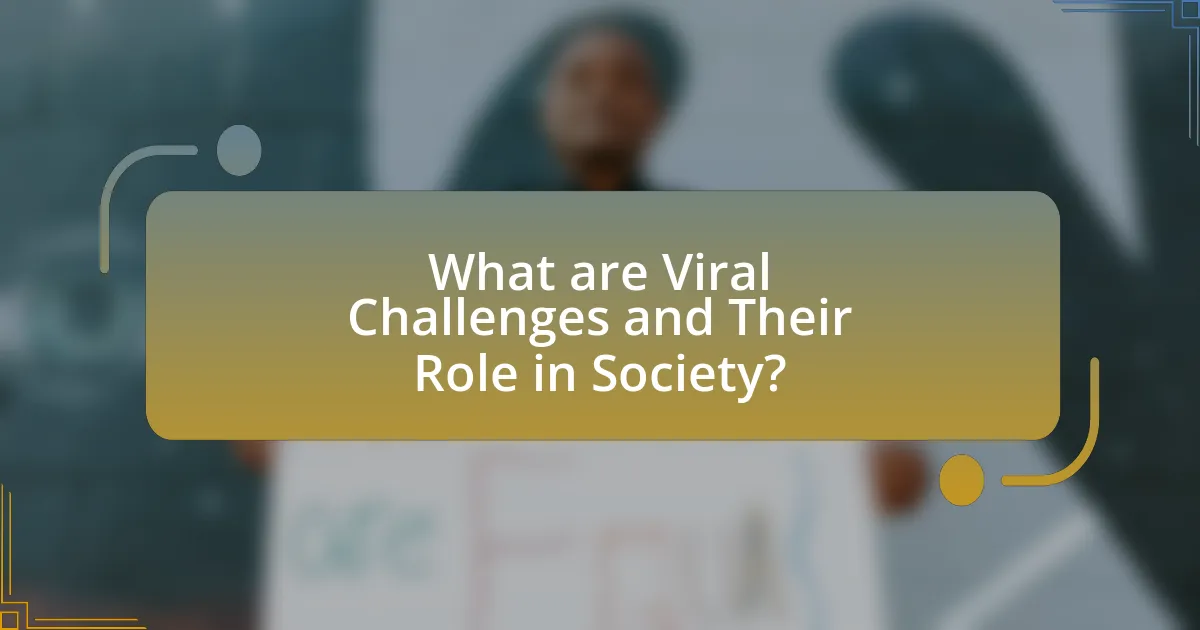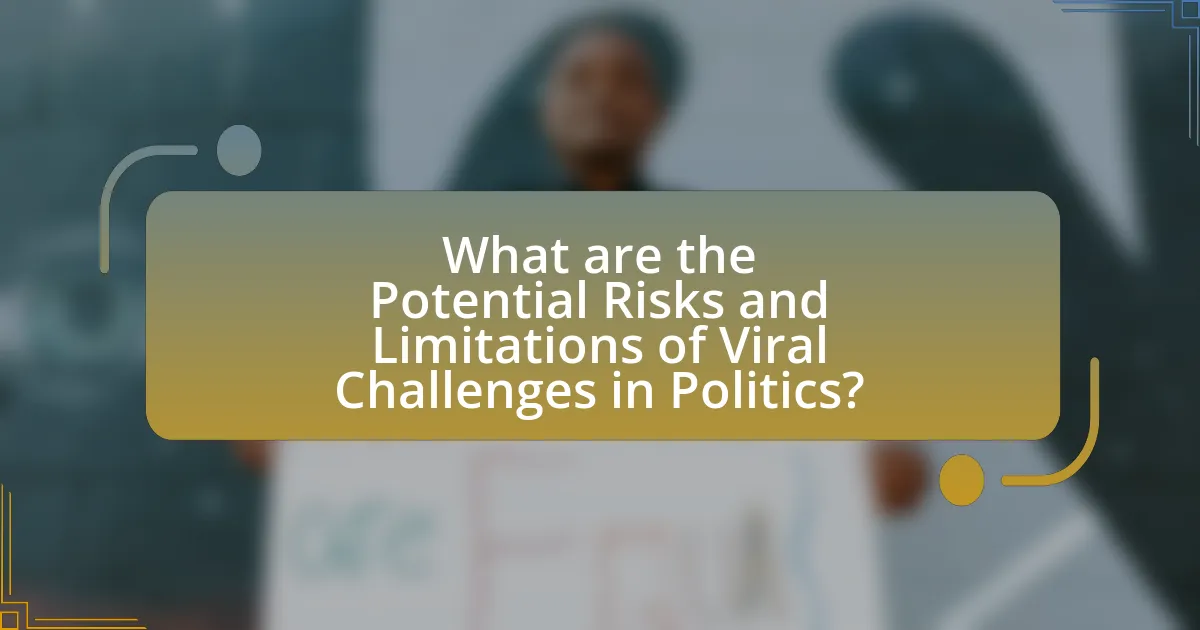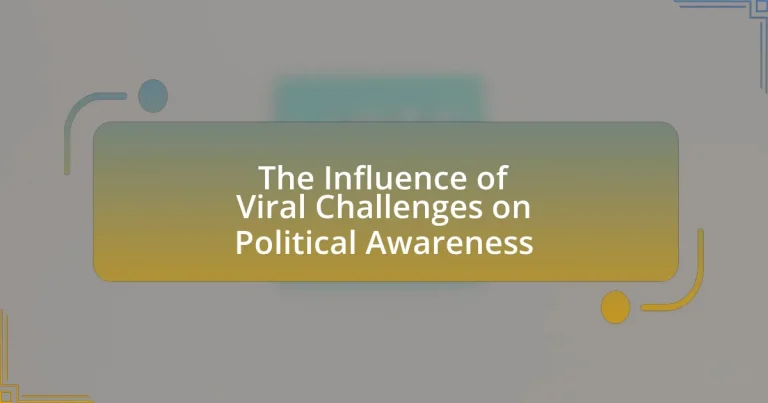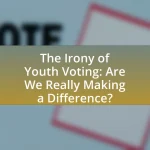Viral challenges are social media phenomena that engage users in specific tasks, often raising awareness about social and political issues. This article explores the origins, spread, and significance of viral challenges in contemporary culture, highlighting their role in mobilizing resources for causes like ALS research and fostering political engagement. It examines the influence of social media platforms, the factors contributing to the virality of challenges, and the potential risks associated with misinformation and oversimplification of complex issues. Additionally, the article discusses how viral challenges can enhance civic engagement, reflect societal values, and mobilize younger demographics for political causes.

What are Viral Challenges and Their Role in Society?
Viral challenges are social media phenomena that encourage users to participate in specific tasks or activities, often leading to widespread engagement and sharing. These challenges can serve various roles in society, including promoting awareness of social issues, fostering community engagement, and influencing cultural trends. For instance, the Ice Bucket Challenge raised over $115 million for ALS research, demonstrating how viral challenges can mobilize resources for important causes. Additionally, viral challenges can enhance political awareness by encouraging discussions around relevant topics, as seen with challenges that address climate change or social justice, thereby shaping public discourse and collective action.
How do viral challenges originate and spread?
Viral challenges originate from social media platforms where users create engaging and often entertaining content that encourages participation. These challenges typically spread through shares, likes, and comments, leveraging algorithms that promote popular content to wider audiences. For instance, the Ice Bucket Challenge gained immense popularity in 2014, raising awareness for ALS by encouraging users to film themselves pouring ice water over their heads and challenge others to do the same. The challenge’s success was fueled by celebrity participation and widespread media coverage, demonstrating how influential figures can amplify reach and engagement.
What platforms are most influential in the dissemination of viral challenges?
Social media platforms, particularly TikTok, Instagram, and Twitter, are the most influential in the dissemination of viral challenges. TikTok’s algorithm promotes short, engaging videos, allowing challenges to spread rapidly among users, evidenced by the platform’s role in popularizing the “Ice Bucket Challenge” and various dance trends. Instagram facilitates visual storytelling and sharing, enhancing the reach of challenges through hashtags and stories, as seen with the “10-Year Challenge.” Twitter’s real-time engagement and trending topics enable challenges to gain traction quickly, demonstrated by the viral spread of the “Blackout Tuesday” initiative. These platforms leverage user-generated content and social sharing, making them pivotal in the viral challenge landscape.
What factors contribute to the virality of a challenge?
The factors that contribute to the virality of a challenge include emotional appeal, social sharing mechanisms, and relatability. Emotional appeal drives engagement, as challenges that evoke strong feelings, such as joy or empathy, are more likely to be shared. Social sharing mechanisms, such as platforms like TikTok or Instagram, facilitate easy dissemination among users, amplifying reach. Relatability ensures that a challenge resonates with a broad audience, making it more likely to be adopted and spread. For instance, the Ice Bucket Challenge gained traction due to its emotional connection to ALS awareness, its shareability on social media, and its simple, relatable premise of pouring ice water over oneself.
Why are viral challenges significant in contemporary culture?
Viral challenges are significant in contemporary culture because they serve as powerful tools for social engagement and awareness, particularly in political contexts. These challenges often mobilize large audiences, encouraging participation and dialogue around pressing issues, such as climate change or social justice. For instance, the Ice Bucket Challenge raised over $115 million for ALS research, demonstrating how a simple viral activity can lead to substantial financial and awareness gains for a cause. Additionally, viral challenges can create a sense of community and collective action, as participants share their experiences and encourage others to join, amplifying the message and fostering a culture of activism.
How do viral challenges reflect societal values and issues?
Viral challenges reflect societal values and issues by serving as a mirror to collective behaviors, beliefs, and concerns within a community. These challenges often highlight pressing social issues, such as climate change, mental health awareness, or racial equality, prompting widespread participation and dialogue. For instance, the Ice Bucket Challenge raised over $220 million for ALS research, showcasing the public’s willingness to engage in philanthropy and awareness-raising efforts. Additionally, challenges like the Black Lives Matter hashtag campaigns illustrate how social media can mobilize collective action and reflect societal demands for justice and equality. Such phenomena demonstrate that viral challenges are not merely entertainment; they are significant cultural artifacts that encapsulate and amplify the values and issues of their time.
What impact do viral challenges have on social interactions?
Viral challenges significantly enhance social interactions by fostering community engagement and shared experiences among participants. These challenges often encourage individuals to connect through social media platforms, creating a sense of belonging and collective participation. For instance, the Ice Bucket Challenge in 2014 raised over $115 million for ALS research, demonstrating how viral challenges can mobilize social networks for a common cause, thereby strengthening interpersonal connections. Additionally, studies indicate that participation in such challenges can lead to increased social capital, as individuals share their experiences and encourage others to join, thus amplifying social ties and interactions within communities.

How do Viral Challenges Influence Political Awareness?
Viral challenges influence political awareness by engaging users in social media platforms, prompting discussions around political issues. These challenges often incorporate themes related to social justice, environmental concerns, or political activism, which can lead to increased visibility and understanding of these topics among participants and their audiences. For instance, the Ice Bucket Challenge raised awareness for ALS, demonstrating how a viral trend can effectively mobilize public interest and funding for a cause. Additionally, studies show that social media interactions during viral challenges can enhance civic engagement, as participants share information and resources related to the political issues highlighted by the challenge.
What mechanisms link viral challenges to political engagement?
Viral challenges link to political engagement primarily through social media amplification, community mobilization, and emotional resonance. Social media platforms facilitate the rapid spread of viral challenges, allowing users to share content widely, which can include political messages or calls to action. This amplification creates a sense of community among participants, fostering collective identity and encouraging individuals to engage in political discourse or activism. Additionally, viral challenges often evoke strong emotions, such as empathy or outrage, which can motivate individuals to take political action. For example, the Ice Bucket Challenge not only raised awareness for ALS but also encouraged discussions about healthcare policies and funding.
How do viral challenges raise awareness about political issues?
Viral challenges raise awareness about political issues by engaging large audiences through participatory and shareable content. These challenges often utilize social media platforms, where users create and share videos or posts that highlight specific political topics, thereby increasing visibility and sparking conversations. For instance, the Ice Bucket Challenge in 2014 not only raised funds for ALS research but also educated millions about the disease and its impact, demonstrating how a simple challenge can mobilize public interest and action around a political cause.
What role do influencers play in shaping political narratives through challenges?
Influencers play a significant role in shaping political narratives through challenges by leveraging their platforms to engage audiences in discussions around political issues. They initiate viral challenges that encourage participation and awareness, often framing political topics in relatable and accessible ways. For instance, the Ice Bucket Challenge raised awareness for ALS, demonstrating how influencers can mobilize their followers to support specific causes and influence public perception. This engagement can lead to increased political activism and awareness, as seen in movements like Black Lives Matter, where influencers used social media challenges to amplify messages and drive participation.
Why do some viral challenges lead to increased political activism?
Some viral challenges lead to increased political activism because they create a sense of community and urgency around specific issues. These challenges often leverage social media platforms to spread awareness rapidly, engaging users in a way that encourages them to participate and share their views. For instance, the Ice Bucket Challenge raised over $115 million for ALS research, demonstrating how a simple viral activity can mobilize individuals toward a common cause. Additionally, challenges that incorporate political themes, such as the Black Lives Matter movement, can galvanize participants to take action, as seen in the widespread participation in related challenges that promote social justice and equality.
What examples illustrate the connection between viral challenges and political movements?
Viral challenges often serve as catalysts for political movements, exemplified by the Ice Bucket Challenge and the Black Lives Matter movement. The Ice Bucket Challenge, which went viral in 2014, raised awareness and funds for ALS research, leading to significant political advocacy for healthcare funding and research initiatives. Similarly, the Black Lives Matter movement gained momentum through viral challenges like the #BlackoutTuesday, which encouraged social media users to post black squares in solidarity against racial injustice, amplifying calls for police reform and social justice legislation. These examples demonstrate how viral challenges can mobilize public sentiment and influence political discourse.
How do viral challenges mobilize younger demographics for political causes?
Viral challenges mobilize younger demographics for political causes by leveraging social media platforms to create engaging and shareable content that resonates with their values and interests. These challenges often incorporate elements of entertainment, creativity, and community participation, making them appealing to younger audiences who are more likely to engage with content that is fun and relatable. For instance, the Ice Bucket Challenge in 2014 raised over $115 million for ALS research, demonstrating how a simple viral challenge can effectively raise awareness and funds for a cause. Additionally, platforms like TikTok and Instagram facilitate rapid dissemination of these challenges, allowing them to reach a wide audience quickly, thus amplifying their impact on political engagement among youth.

What are the Potential Risks and Limitations of Viral Challenges in Politics?
Viral challenges in politics pose significant risks and limitations, primarily including the spread of misinformation, oversimplification of complex issues, and potential for polarization. Misinformation can rapidly circulate through social media platforms, leading to public confusion and misinformed opinions, as evidenced by the viral spread of false narratives during elections, which can influence voter behavior. Additionally, these challenges often reduce multifaceted political topics to simplistic slogans or memes, hindering nuanced understanding and critical discourse. This oversimplification can alienate individuals who may feel that their concerns are not adequately represented, contributing to political polarization, where communities become more divided in their beliefs. Research indicates that social media algorithms favor sensational content, further exacerbating these issues by promoting divisive narratives over constructive dialogue.
What negative consequences can arise from viral political challenges?
Viral political challenges can lead to misinformation and polarization among the public. Misinformation spreads rapidly through social media platforms, often resulting in individuals forming opinions based on false narratives. For instance, during the 2020 U.S. presidential election, various viral challenges propagated misleading information about candidates, which contributed to increased division among voters. Additionally, these challenges can trivialize serious political issues, reducing complex topics to simplistic memes or slogans that fail to encourage informed discourse. This oversimplification can hinder meaningful engagement with political content, ultimately affecting civic participation and understanding.
How can misinformation spread through viral challenges affect political awareness?
Misinformation spread through viral challenges can significantly distort political awareness by promoting false narratives and misleading information. Viral challenges often reach a wide audience rapidly, leading individuals to accept and share inaccurate content without critical evaluation. For instance, a study by the Pew Research Center found that 64% of Americans believe that misinformation has caused confusion about basic facts regarding political issues. This confusion can lead to misinformed opinions and voting behaviors, ultimately affecting democratic processes and civic engagement.
What are the ethical considerations surrounding viral challenges in political contexts?
Viral challenges in political contexts raise significant ethical considerations, primarily concerning misinformation, manipulation, and the potential for harm. Misinformation can spread rapidly through viral challenges, leading to distorted public perceptions and undermining informed decision-making. For instance, during election cycles, challenges that misrepresent candidates or policies can skew voter opinions and influence electoral outcomes.
Manipulation is another ethical concern, as political entities may exploit viral challenges to create divisive narratives or mobilize specific demographics, often without transparency. This manipulation can erode trust in democratic processes and institutions. Additionally, the potential for harm arises when challenges encourage risky behaviors or promote hate speech, which can lead to real-world violence or discrimination.
These ethical considerations highlight the need for accountability and responsible engagement with viral challenges in political discourse to safeguard democratic integrity and public well-being.
How can the effectiveness of viral challenges in promoting political awareness be measured?
The effectiveness of viral challenges in promoting political awareness can be measured through engagement metrics, sentiment analysis, and changes in political knowledge or behavior. Engagement metrics, such as the number of participants, shares, and comments, indicate the reach and impact of the challenge. For instance, the Ice Bucket Challenge in 2014 raised over $115 million for ALS research, demonstrating significant engagement and awareness. Sentiment analysis of social media posts related to the challenge can reveal public attitudes towards the political issues being highlighted. Additionally, pre- and post-challenge surveys can assess shifts in political knowledge or voter turnout, providing concrete evidence of the challenge’s influence on political awareness.
What metrics can be used to assess the impact of viral challenges on political engagement?
Metrics that can be used to assess the impact of viral challenges on political engagement include social media engagement rates, participation in related political discussions, and changes in voter turnout. Social media engagement rates, such as likes, shares, and comments on posts related to viral challenges, indicate the level of public interest and interaction with political content. Participation in discussions, measured through hashtags or comments on platforms like Twitter and Instagram, reflects how viral challenges stimulate political discourse. Additionally, analyzing changes in voter turnout before and after viral challenges can provide concrete evidence of their influence on political mobilization, as seen in studies that link social media campaigns to increased electoral participation.
How do different demographics respond to viral challenges in political contexts?
Different demographics respond to viral challenges in political contexts based on factors such as age, socioeconomic status, and cultural background. For instance, younger individuals, particularly those aged 18-29, are more likely to engage with and share viral political challenges on social media platforms, as evidenced by a Pew Research Center study indicating that 71% of this age group uses social media for political information. In contrast, older demographics, such as those over 50, tend to engage less frequently with these challenges, often due to lower social media usage rates and differing communication preferences. Additionally, individuals from diverse socioeconomic backgrounds may respond differently; those with higher education levels often participate more actively in political viral challenges, reflecting a greater awareness of political issues. This variation in engagement highlights how demographic factors shape the interaction with viral political content, influencing overall political awareness and participation.
What best practices can enhance the positive impact of viral challenges on political awareness?
To enhance the positive impact of viral challenges on political awareness, organizations should focus on creating engaging, informative content that encourages participation and discussion. Engaging content, such as relatable narratives or compelling visuals, can capture attention and motivate individuals to share their perspectives. Additionally, incorporating clear calls to action that direct participants to credible sources or encourage them to engage in civic activities can further amplify awareness. Research indicates that social media campaigns that utilize hashtags effectively can increase visibility and foster community engagement, as seen in the #BlackLivesMatter movement, which successfully raised awareness about racial injustice and mobilized political action.
How can creators design challenges that promote informed political discourse?
Creators can design challenges that promote informed political discourse by incorporating fact-checking elements and encouraging critical thinking. For instance, challenges can require participants to research specific political topics, share verified information, and engage in discussions that highlight diverse perspectives. This approach not only fosters a deeper understanding of political issues but also combats misinformation. Research indicates that interactive learning experiences, such as challenges, can enhance knowledge retention and engagement, making participants more likely to engage in informed discussions.
What strategies can organizations use to leverage viral challenges for civic engagement?
Organizations can leverage viral challenges for civic engagement by creating relatable and shareable content that encourages participation and awareness. By designing challenges that resonate with current social issues, organizations can tap into existing public sentiment, as seen with the Ice Bucket Challenge, which raised over $115 million for ALS research. Additionally, incorporating social media platforms for widespread dissemination allows for rapid engagement, as evidenced by the #MeToo movement, which mobilized millions to share their experiences and raise awareness about sexual harassment. Collaborating with influencers can further amplify reach, as influencers can motivate their followers to participate, thereby increasing visibility and impact.


